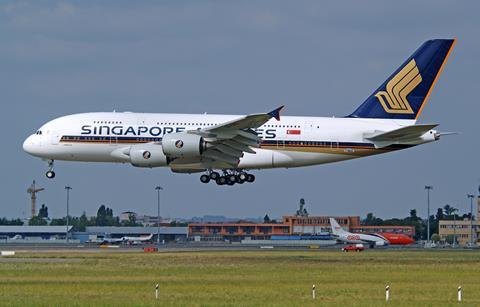Singapore Airlines Group expects to take delivery of 32 aircraft in the coming 12 months including eight Boeing 737 Max 8s, although it is uncertain when the type will return to service in the region.
Taken together with five aircraft that will exit the fleet, the group — which also includes Scoot and SIA Cargo — will record a net increase of 27 jets in the year to 31 March 2022.

Fleet development plans shared during a briefing following the release of its full-year results indicate mainline carrier SIA to take delivery of 12 other jets, including six Airbus A350-900s and five 787-10s.
In addition to travel restrictions related to the coronavirus pandemic, the 737 Max is still banned from flying in Singapore and and most parts of the Asia-Pacific, including China and India. In February, Australia lifted the type’s grounding - the only major market in the region to have done so.
“What happens moving forward is really fluid, because it depends on the authorities ungrounding the 737 Max, including Singapore [and] other jurisdictions that the Max will fly to,” says executive vice president for finance and strategy Tan Kai Ping.
“We have in our agreement with Boeing, in our order book, eight to be delivered this financial year. Obviously we will have to see what happens with the ungrounding,” he adds.
SIA in March told FlightGlobal it was working to “progressively” bring the Max out from long-term storage. Tan did not indicate the delivery schedule of the eight 737s, which will take the airline’s 737 Max fleet to 14 examples by April next year.
Meanwhile, low-cost arm Scoot expects to take 10 A321neos on direct lease, following “unsuccessful” deferral negotiations with lessors BOC Aviation and SMBC Aviation Capital.
“We have sought to defer the delivery of the aircraft [but] have been unsuccessful in the negotiations,” says Scoot chief executive Campbell Wilson. Cirium fleets data indicates the low-cost carrier to have 16 A321neos on order, alongside 28 A320neos and seven 787s.
The group’s latest fleet development plans come a day after it disclosed it retired another 12 aircraft earlier than scheduled — including four 777-300ERs.
It has removed 45 aircraft it deemed “surplus to fleet requirements” through the financial year, and had in February tweaked its order book — by swapping 787-10s for more 777-9s — to defer capital expenditure.
As for the fate of its A380 fleet, SIA chief Goh Choon Phong says the 12 examples it has “will be put to good use in the future”, but did not elaborate.

A number of operators globally are putting the type out of service, amid sluggish travel demand following the coronavirus outbreak. So far, the A380s are all in storage, according to Cirium fleets data.
SIA Group plunged to record losses for the year ended 31 March, reporting an operating loss of S$2.5 billion ($1.9 billion) on the back of a 98% plunge in traffic year on year. Steep impairment costs — mostly from the early aircraft retirement — brought the group’s net loss to a staggering S$4.3 billion for the full year.
Tan says the group “does not expect” to see impairment costs of the current magnitude in the coming financial years, which will help bring down its net loss.
In the coming months, SIA expects to bring capacity up to 32% pre-pandemic levels, and fly to nearly half the number of points it used to fly before the pandemic struck. Still, traffic remains tepid: load factors since the start of the year has remained between 10-14%, despite an uptick in capacity.


























